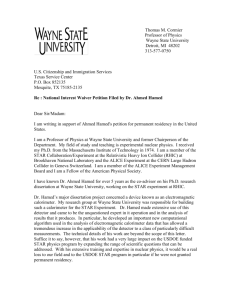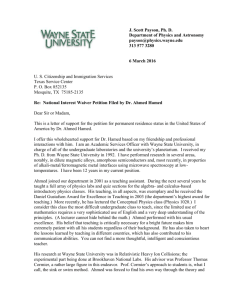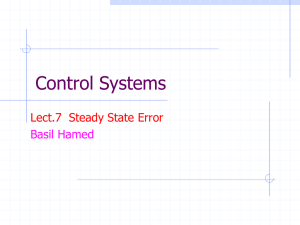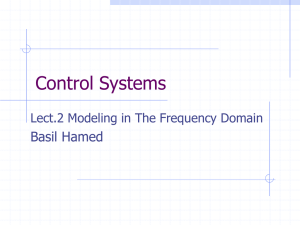Control Systems
advertisement
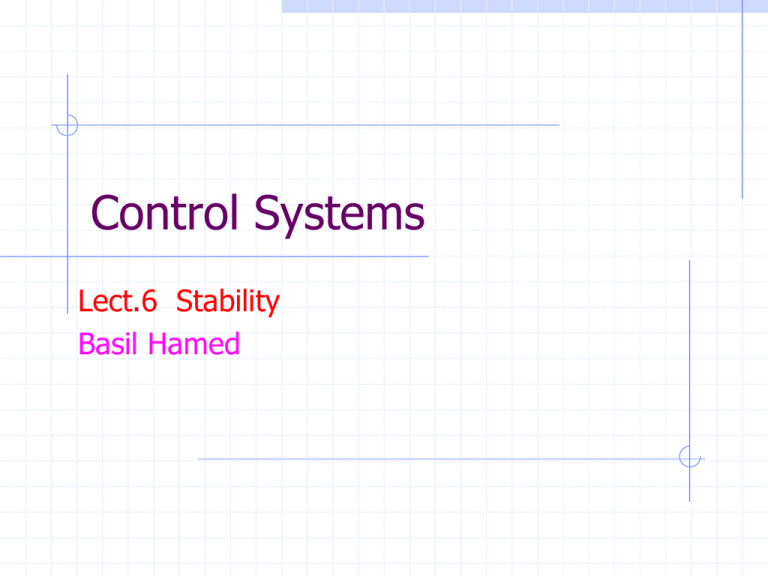
Control Systems Lect.6 Stability Basil Hamed Chapter 6 After completing this chapter the student will be able to: • Make and interpret a basic Routh table to determine the stability of a system (Sections 6.1-6.2) • Make and interpret a Routh table where either the first element of a row is zero or an entire row is zero (Sections 6.3-6.4) • Use a Routh table to determine the stability of a system represented in state space (Section 6.5) Basil Hamed 2 Stability – A Simple Example We want the mass to stay at x = 0, but wind gave some initial speed (f(t) = 0). What will happen? How to characterize different behaviors with TF? Basil Hamed 3 Stability – Importance • The most basic and important specification in control analysis and synthesis! • Unstable systems have to be stabilized by feedback. • Unstable closed-loop systems are useless. – What happens if a system is unstable? • may hit mechanical/electrical “stops” (saturation) • may break down or burn out Basil Hamed 4 Stability–What Will Happen to Unstable Systems? Tacoma Narrows Bridge (July 1-Nov.7, 1940) Wind-induced vibration Collapsed! 2008… Basil Hamed 5 6.1 Introduction • Three requirements enter into the design of a control system: transient response, stability, and steady-state errors. Thus far we have covered transient response, which we will revisit in Chapter 8. We are now ready to discuss the next requirement, stability. • Stability is the most important system specification. If a system is unstable, transient response and steady-state errors are moot points. • An unstable system cannot be designed for a specific transient response or steady-state error requirement. Basil Hamed 6 6.1 Introduction What is stability? There are many definitions for stability, depending upon the kind of system or the point of view. In this section, we limit ourselves to linear, time-invariant systems. A system is stable if every bounded input yields a bounded output. We call this statement the bounded-input, bounded-output (BIBO) definition of stability. A system is unstable if any bounded input yields an unbounded output. Basil Hamed 7 Stability – Definition BIBO (Bounded-Input-Bounded-Output) stability : Any bounded input generates a bounded output Asymptotic stability : Any ICs generates y(t) converging to zero. Basil Hamed 8 6.1 Introduction we present the following definitions of stability, instability, and marginal stability: • A linear, time-invariant system is stable if the natural response approaches zero as time approaches infinity. • A linear, time-invariant system is unstable if the natural response grows without bound as time approaches infinity. • A linear, time-invariant system is marginally stable if the natural response neither decays nor grows but remains constant or oscillates as time approaches infinity. Basil Hamed 9 6.1 Introduction How do we determine if a system is stable? Let us focus on the natural response definitions of stability • Stable systems have closed-loop transfer functions with poles only in the left half-plane. • If the closed-loop system poles are in the right half of the splane and hence have a positive real part, the system is unstable. Basil Hamed 10 6.1 Introduction Basil Hamed 11 6.1 Introduction Basil Hamed 12 Stability – “s” Domain Stability For a system represented by a transfer function G(s), system is BIBO stable All the poles of G(s) are in the open left half of the complex plane system is asymptotically stable Basil Hamed 13 Stability – Remarks on Stability Definition • For a general system (nonlinear etc.), BIBO stability condition and asymptotic stability condition are different. • For linear time-invariant (LTI) systems (to which we can use Laplace transform and we can obtain a transfer function), the conditions happen to be the same. • In this course, we are interested in only LTI systems, we use simply “stable” to mean both BIBO and asymptotic stability. Basil Hamed 14 Stability – Examples Basil Hamed 15 Stability – Summary • Stability for LTI systems – (BIBO and asymptotically) stable, marginally stable, unstable – Stability for G (s) is determined by poles of G. • Next – Routh-Hurwitz stability criterion to determine stability without explicitly computing the poles of a system. Basil Hamed 16 6.2 Routh-Hurwitz Criterion In this section, we learn a method that yields stability information without the need to solve for the closed-loop system poles. Using this method, we can tell how many closed-loop system poles are in the left half-plane, in the right half-plane, and on the jw-axis. (Notice that we say how many, not where.) The method requires two steps: (1) Generate a data table called a Routh table (2) interpret the Routh table to tell how many closed-loop system poles are in the LHP, the RHP, and on the jw-axis. Basil Hamed 17 Generating a Basic Routh Table Look at the equivalent closed-loop transfer function shown in Fig Since we are interested in the system poles, we focus our attention on the denominator. In order the above characteristic eq. does not have roots in RHP, it is necessary but not sufficient that the following hold; 1. All the coefficient of the polynomial have the same sign. 2. None of the coefficient vanishes. Basil Hamed 18 Generating a Basic Routh Table We first create the Routh table shown in Table below Basil Hamed 19 Generating a Basic Routh Table Only the first 2 rows of the array are obtained from the characteristic eq. the remaining are calculated as follows; Basil Hamed 20 Stability – Routh-Hurwitz Example Find the stability of the characteristic eq; Basil Hamed 21 Example 6.1 P. 306 PROBLEM: Make the Routh table for the system shown in Figure Basil Hamed 22 Example 6.1 P. 306 SOLUTION: The first step is to find the equivalent closed-loop system because we want to test the denominator of this function. System is unstable and has 2 poles in RHP. Basil Hamed 23 Example Consider the equation Solution Because the equation has no missing terms and the coefficients are all of the same sign, it satisfies the necessary condition System is unstable because there are two sign changes in the first column of the tabulation, the equation has two roots in the right half of the .y-plane. Basil Hamed 24 6.3 Routh-Hurwitz Criterion: Special Cases Two special cases can occur: (1) The Routh table sometimes will have a zero only in the first column of a row, or (2) The Routh table sometimes will have an entire row that consists of zeros Basil Hamed 25 Zero Only in the First Column • If the first element of a row is zero, division by zero would be required to form the next row. • To avoid this phenomenon, an epsilon, ε, is assigned to replace the zero in the first column. • The value ε is then allowed to approach zero from either the positive or the negative side, after which the signs of the entries in the first column can be determined. Basil Hamed 26 Example 6.2 P.308 PROBLEM: Determine the stability of the closed-loop transfer function A sign change from the s3 row to the s2 row, and there will be another sign change from the s2 row to the s1 row. Hence, the system is unstable and has two poles in the right half-plane. Basil Hamed 27 Entire Row is Zero We now look at the second special case. Sometimes while making a Routh table, we find that an entire row consists of zeros. Reason for entire row is zero; it indicates one or more of the following exist: (1) The roots are symmetrical and real, (2) the roots are symmetrical and imaginary, or (3) the roots are quadrantal. Basil Hamed 28 Entire Row is Zero To continue with Routh's tabulation when a row of zero appears, we conduct the following steps: 1. Form the auxiliary equation P(s) = 0 by using the coefficients from the row just preceding the row of zeros. 2. Take the derivative of the auxiliary equation with respect to s; this gives dP(s)/ds = 0. 3. Replace the row of zeros with the coefficients of dP(s)/ds . 4. Continue with Routh's tabulation in the usual manner with the newly formed row of coefficients replacing the row of zeros. 5. Interpret the change of signs, if any, of the coefficients in the first column of the Routh's tabulation in the usual manner. Basil Hamed 29 Example 6.4 P. 310 PROBLEM: Determine the number of right-half-plane poles in the closed-loop transfer function Solution Basil Hamed 30 Example 6.4 P. 310 Basil Hamed 31 6.4 Routh-Hurwitz Criterion: Additional Examples Example 6.6 Find the stability of the system shown. SOLUTION: First, find the closed-loop transfer function as The system is unstable, since it has two right-half plane poles and two left-half-plane poles. Basil Hamed 32 Example 6.7 P.314 Find the stability of the system SOLUTION: The closed-loop transfer function is there are two sign changes, and the system is unstable, with two poles in the right half-plane. The remaining poles are in the left half-plane. Basil Hamed 33 Example 6.8 P.314 Find the stability of the system SOLUTION: The closed-loop transfer function for the system The closed-loop system is unstable because of the right-half-plane poles. Basil Hamed 34 Example 6.9 P. 318 PROBLEM: Find the range of gain, K, for the system shown, that will cause the system to be stable, unstable, and marginally stable. Assume K > 0. SOLUTION: First find the closed-loop transfer function as i) For stable System 0>k>1386 ii) For Unstable System k <1386 iii) For marginal stable k= 1386 Basil Hamed 35 Example Consider that the characteristic equation of a closed-loop control system is Solution: It is desired to find the range of K so that the system is stable. From the 𝑠 2 row, the condition of stability is K > 0, and from the 𝑠1 row, the condition of stability is Basil Hamed 36 Stability – Control Example . Determine the range of K that stabilize the closed-loop system Basil Hamed 37 Stability – Control Example Basil Hamed 38 Stability – Control Example Characteristic equation If K = 35, oscillation frequency is obtained by the auxiliary equation Basil Hamed 39 6.5 Stability in State Space • Up to this point we have examined stability from the s-plane viewpoint. Now we look at stability from the perspective of state space. • Stability of State Space depends on eigenvalues of matrix A. Because the values of the system's poles are equal to the eigenvalues of the system matrix, A. • eigenvalues of matrix A is found by det(sI - A) = 0 Basil Hamed 40 Example 6.11 P. 321 PROBLEM: Given the system Find out how many poles are in the left half-plane, in the right halfplane, and on the jw-axis. SOLUTION: First form (sI - A): Basil Hamed 41 Example 6.11 P. 321 Now find the det(sI — A): Since there is one sign change in the first column, the system has one right half- plane pole and two left-halfplane poles. It is therefore unstable. Basil Hamed 42
